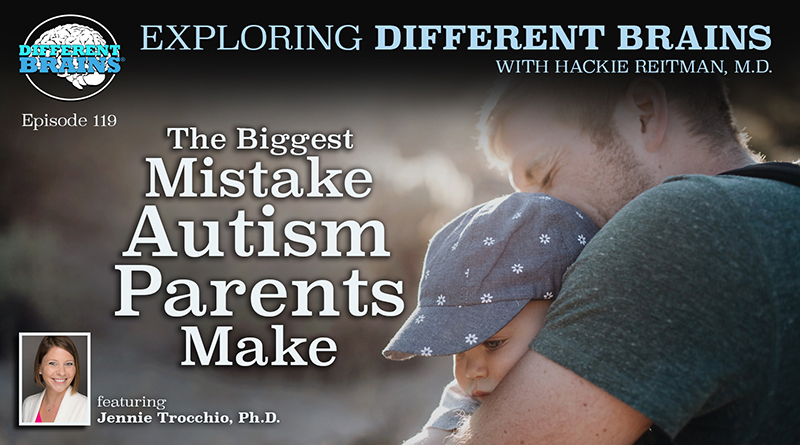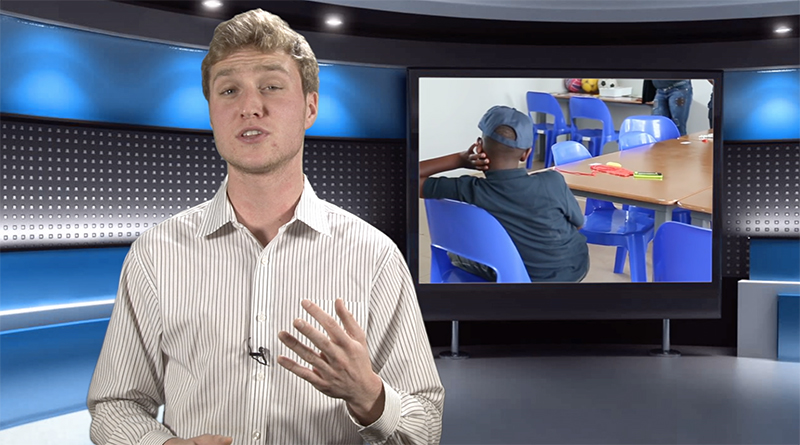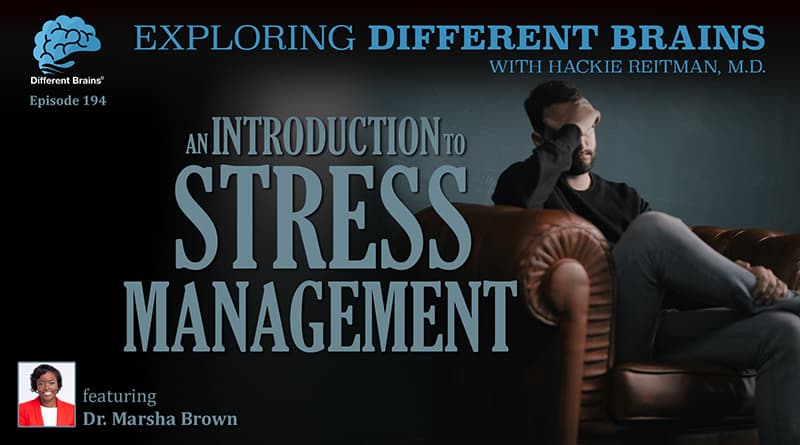
The Biggest Mistake Autism Parents Make, with Jennie Trocchio, Ph.D. | EDB 119
(16 mins) In this episode, Dr. Hackie Reitman continues his conversation with Jennie Trocchio, Ph.D.. Dr. Trocchio is an autism educator, consultant, and DIR/Floortime provider. Dr. Trocchio discusses the need for people to learn the interests of and relate to people on the spectrum, and answers the question of what the biggest mistake the parents of kids with autism make.
For more about Dr. Jennie Trocchio, visit: www.drjennietk.com
.
63 Second Preview:
.
To listen or download the podcast version of this episode, see the embedded player below.
Or look for us on your favorite podcast provider:
iTunes | Stitcher | SoundCloud
[expand title=”View Full Transcript”]
HACKIE REITMAN, M.D. (HR): Hi, I’m Dr. Hackie Reitman. Welcome to another episode of Exploring Different Brains. Today, we’re so lucky. We have the return of my friend, Dr. Jennie Trocchio, who is an autism educational specialist and so much more. Jennie, welcome again to Different Brains.
JENNIE TROCCHIO, Ph.D. (JT): Thank you so much for having me here. I’m so excited to be back, to see you, to see your gang. I appreciate the opportunity.
HR: Now, my daughter Rebecca is always reminding me, “Dad, sometimes good intentions are not enough,” and parents have great intentions, but what is, like, some of the biggest, what is the biggest mistake that parents make when they’re interacting with their children on the spectrum? Or their adults, for that matter?
JT: The biggest mistake? Umm, I think, possibly, the biggest mistake I see is that parents are interacting at a different, a different level, often a little bit too high, umm, and not taking the time to just watch their kids, and think about what are they doing and why. Sometimes I like to say, “Ok, let’s just take a minute, back up. And instead of just coming in with our agenda,” and I guess that’s really what I see parents doing. They come in with their agenda. And, you know, today we’re gonna do this, this, and this. Umm, but instead, let’s take a minute, watch what the child’s doing, and think about where’s their attention, and what is their intention. What are they trying to do? And then we can kind of figure out why, and then we can join them in that. Umm, but coming in and just kind of directing a lesson is what it feels like sometimes, instead of just playing, taking time to, to find joy and to have fun and to smile. And that’s, uhh, I think that if every parent would take two hours out of a day, I know that sounds like a lot, but when you see the data about how often we’re on our phones and devices, it’s kind of small potatoes, but like two hours, that’s, 15 minute increments, totally manageable, excuse me as I’m processing this, umm, but two hours to play, to have fun, to interact in a way-
HR: To connect.
JT: …that’s enjoyable, to connect, I think if every family could do that, you would know one another a lot better, relationships would be stronger, and would really be able to, to get some momentum going.
HR: Once, when I was speaking at a conference out in Tuscon, Arizona, umm, one of the, umm, uhh, panelists and speakers was Raun Kaufman, who has a, he’s got a center up in Massachusetts, but, umm, he did a like a little play, a little, mini play, and, umm, the, to show how to connect what you’re saying. And it’s funny how this visual, this little, two minute play really made an impression on me. So there’s a, a woman sitting on a park bench, reading a book. And he, he plays it out two ways. He comes over like a bull in a china shop, says, “Hey, you want to go to the movies?” “Leave me alone; I’m reading my book,” you know, kind of thing. Umm, then he plays it out a different way. He comes over and sits on the bench next to her, with his own book, doesn’t say a word. Does that for a couple of days. Then, one day, he says, “Oh, what are you reading?” She goes, “Oh, I’m reading this,” “Oh, what a coincidence, I’m reading a book by the same author,” did that. Then they decide to discuss the next day the author and everything, and then, after so many days and everything and getting to know, he says, “Hey, there’s a movie based on a book by that author that’s playing. Would you like to join me?” And that made an impression that if we, as parents, first take the time to connect, or as teachers, or as doctors, or as you name it, employers, you get more out of it, too. For instance, if you’re an employer, I got to employers and say, “Look-” and to doctors too, “…if you, you’re already treating people on the spectrum; you may not even realize it. This will improve your bottom line. You can make more money, Mr. Employer, Mr.-”
JT: Mhm.
HR: “…Doctor, umm, but you have to just treat everybody on an individual basis, because we all, we all are different,” And that’s the essence of the DR, DIR Floortime is what, what you’re saying.
JT: Absolutely.
HR: Umm, how can we expand this to the adult population of those of us whose brains are different?
JT: On an, on an adult level, I mean, I think you just actually used a great example of, you know, having doctors just connect with their patients first, instead of just, you know, looking at the symptoms and immediately saying, “Ok, well, this is wrong; this is wrong, so this is how we’re going to treat it,” saying, “How are you feeling? How are you?” you know, “What, what do you like to do? Let’s find ways to fit what will work into your everyday routine. Like how can we make this sustainable for you? How can we make it effective for you?” Because we’re all so different that there, there’s no one size fits all sort of strategy that’ll work, you know? Not everyone can take a, you know, little, I don’t know, little purple pill, and all of a sudden, headaches are gone forever, you know? That would be great, but that, that’s not, that’s not who we are.
HR: No, and this time when I gave a talk to the American Academy of Orthopedic Surgeons, I think it was their first neurodiversity talk; I said, “You know, remember that patient who came in when you went to take off the fiberglass cast, and you turned on the loud cast cutter, they went crazy and you thought it was just bad parenting and it slowed up your office for a half hour?”
JT: Mhm.
HR: I said, “No, that, I didn’t know my daughter’s senses, all of her senses were hyper.”
JT: Yes.
HR: “Touch, feel, smell, sound, lights, everything, and if you know that, then you can adapt to it, and you might have used a plaster cast instead and have them soak it off-”
JT: Mhm.
HR: “…or something like that.”
JT: And the sensory bit is really so critical, and a lot of people don’t know about it. A lot of professionals don’t know about it; a lot of parents don’t know about it, but the sensory needs are huge. Umm, I’ve actually started doing, umm, talks in schools and inclusion classes for the typical. “Typical”, who’s “typical”, right? The “typical” kids, umm, and I call it “Autism Superpowers”. And I find that so often, you know, a child might have behaviors that, that are quirky, you know, that look weird or you don’t really understand why, but so often if you just explain to everyone the sensory bit, and you know, sometimes they hear things that you don’t hear. Sometimes, they can’t feel their bodies. And you just explain it, but in terms of a superpower, and that’s really how I view it, umm, so many of our, I mean, the strengths in that are just tremendous. But when you explain it, then people understand. So in a classroom once, I gave a talk to, to the typical peers about this boy who had very sensitive smell, for example, and he could smell things no one else could smell. And one day, he, he was having an absolute tantrum in the classroom and the teacher immediately, you know, “That’s wrong, time out!” and kind of was pushing him away and was really yelling at him. And he was having a really hard time regulating, I mean, he was very upset because, well, we didn’t know why. Umm, then one of the peers raised his hand and said, “Well, don’t you remember? He has the superpower of smell. And can’t you smell that pizza that’s burnt from the cafeteria? Like, don’t you think that could be it?” to the teacher, who then immediately said, “Well, I think you could be correct, so why don’t we take a walk outside, you know, and then come back and everything’s fine.” I think you’re right that when you understand how that individual’s processing the world, what they see, hear, feel, what they like, it changes the game.
HR: And this gets into another thing where, you know, which goes to the education of our teachers. It’s not their fault. Doctors, too.
JT: Yes.
HR: MDs get zero training on all this stuff. But for instance, where, uhh, my daughter Rebecca was teaching part time, in, in a, the Asperger’s program along with her mentor, the special ed teacher Patty Fizzano, both of whom contributed to the Aspertools book, umm, they would approach it just “common
sensically”. So they would give Rebecca the toughest students to tutor one on one in math. And she had this one kid that they were going to throw out of the school; he was acting out; he was snarling at everybody; you know, he was nasty, you know, wouldn’t sit still. And so she took him in another room after talking to the parents and the teacher and, uhh, he’s sitting there, like, snarling, and she goes, “Before we start, one thing: Do you want to sit or do you want to pace?” He goes, “You’ll let me pace?” She goes, “Yeah, as long as you do the work.” He’s walking back and forth, no problem, getting hundreds.
JT: Yes. Yes.
HR: Another kid, umm, wouldn’t stop the self stimming. You know, he’s pounding his foot like that. So what they did was they put a rubber kind of band across the bottom of his desk so he could do it without it bothering everybody.
JT: Mhm.
HR: Instead of that ending his career, you have to leave the class or you have to be in a spec-, you know, and it’s the individuality which, to my surprise, in some, my reading, I found that you get some of the most individualized teaching in the one room schools in rural America, where each kid has their own computer and the teacher walks around. And they’re all different grades in the same thing, and, and kind of do it like that. Another thing that was very uhh, interesting to me: I had an offer to become a professor at Nova Southeastern but it sounded like too much work, but, umm, they have a wonderful, wonderful, uhh, program there. They have, uhh, Tom Temple with his whole, uhh, TRED, the Translational Research and Economical Development. In addition to their osteopathic school and all their other programs, they just brought in an allopathic MD medical school. And, uhh, the uhh, the dean of that school, umm, has uhh, brought in uhh, a, the method of teaching where they’ve done away with subjects. Umm, and it’s very interesting. So they’re actually doing that right now at Nova Southeastern, in the medical school. And umm, I think that the way things are moving, it’s going to get back to, this is just my opinion, the double edged sword of modern technology. How are we going to use it? And to what extent are you going to use it? And to what extent are you going to isolate, uhh, the individual from real social situations? And I don’t know the answer to that.
JT: I’m with you. I’m with you 100%. And, and it’s interesting that you’re, you’re bring up these one room sorts of schools, because I’ve seen a little bit of a trend popping up recently where, and you know I run, I co-run a couple of great support groups for parents. Umm, and a big issue that people are talking about right now is schools and you know, if they don’t love their school now, where are they going to go next year. And people are kind of comparing options, and, and not super enthusiastic. Umm, but I’ve been hearing about this new trend called “unschooling”, and I think that there might be something to it, and it’s all about, umm, you know, learning in a totally unconventional way. So I actually visited a school recently. It’s up in Tamarac, called “The Evolve Learning Community”, and what they do is they teach things like, umm, executive functions, focus, concentration, peer competition through chess. And chess is one of their subjects that’s taught every day, and, and the kids really enjoy it, and then they have problem solving time and they have, but, you know, it’s a very similar sort of concept.
HR: The biggest advice you have for parents is to try to connect and spend time with your kid, you know, it’s, I’ve always been surprised, when I ask parents “What is your child interested in?” they, many of them don’t have a good answer, and yes, the, the kid or the adult “What are you interested in?”, they’re glad to tell you. It’s like nobody’s listening.
JT: Exactly. There’s just some sort of mismatch here.
HR: Yeah.
JT: But just taking time to play, you know, taking time to interact and taking time to put devices down. Umm, I think that’s pretty big, because similarly, I ask every parent I meet, you know “How do you guys play?” and it’s amazing how often the answer, the initial answer is a device, you know? “Oh, we play Candy Crush. We play Fruit Ninja,” but that’s not really playing, you know? And if you think about play, traditional play with another pe-, it’s with another person, first of all, not a device, and you’re using your body and you’re thinking and you’re communicating and you’re problem solving and, I mean, the benefits of play are just, it’s like the perfect therapy, all in one. And I actually read recently that play is the number one way to umm, to increase the neural connections. Umm, wait, there’s a term I’m thinking of. What is it? Umm, I want to say neurodiversity but that’s not true. Umm-
HR: Neuroplasticity.
JT: Thank you so much. Neuroplasticity. Play is the number one way to increase neuroplasticity in our brains. And I think that’s pretty huge, and the fact that we’re not playing umm, it’s, it, uhh, it worries me, to be honest. So I would like to see a little bit more play.
HR: More play.
JT: More play.
HR: Well, that’s what we’re going to, you know, we’re going to end this on a high note. Play more!
JT: Woo hoo!
HR: Uhh, Dr. Jennie Trocchio, it’s been such a pleasure to have you here. How can people get in touch with you who want to get in touch with you directly?
JT: So, um, feel free, I, to visit my website, umm, www.drjennietk.com. I also have a Facebook page, Autism Education and Development Solutions, umm, I’m on Twitter, I am on really, you name it, you can find me if you can spell my name, J-E-N-N-I-E T-R-O-C-C-H-I-O, you can find me; I promise. And I look forward to talking to anyone, everyone about how we can, you know, get the world a little bit more; how can we get a little more play in the world, right?
HR: Great. Jennie Trocchio, thank you so much for being with us here at Different Brains.
JT: Of course. Thank you for having me.
[/expand]
.




